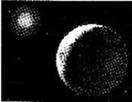1 . Have you ever looked at the sky and thought about darkness? Is it nothing? Or is there something in the dark? Cosmologists (宇宙学家) try to answer questions about things in space. They even study the darkness in space. They say the universe is about 5 percent “normal” matter—things we can see, like Earth and other planets, and the sun and other stars. But about 70 percent of the universe is something called dark energy.
Cosmologists say the other 25 percent of the universe is dark matter. Dark matter has some weight. It’s heavy so we know it’s there. But we can’t see it, so it is very hard to study something that you can’t see!
One possible kind of dark matter is a brown dwarf (褐矮星). A brown dwarf is too big to be a planet and too small to be a star. Brown dwarfs are colder than stars, and they don’t give off light that people can see. Cosmologists found them by using a telescope that finds heat. They found the first brown dwarf in 1995.
Cosmologists know a lot about one kind of dark matter—black holes. In 1783, an English astronomer, John Michell, guessed that there were black holes. But cosmologists didn’t find any black holes until 188 years later. Since then, they’ve found many black holes in space.
It’s very dark with much gravity (引力) in a black hole. There is so much gravity in a black hole that nothing can get out, not even light. This is why we can’t see them. Cosmologists find black holes by looking at things around them.
For example, stars and gases near a black hole move very fast.
Things in space can fall into a black hole, and when they do, they can never get out. But don’t worry—Earth will never fall into a black hole because there is not one close enough.
1. When did cosmologists first find black holes?| A.In 1783. | B.In 1971. | C.In 1995. | D.In 1595. |
| A.They are as big as planets or stars. | B.They give off light that people can sec. |
| C.The first one was found by using a telescope. | D.They are much hotter than stars and planets. |
| A.Black Holes in Space. | B.Dark Energy in Space. |
| C.Normal Matter in the Universe. | D.Dark Matter in the Universe. |
| A.We have known nothing about dark matter so far. |
| B.Earth could fall into a black hole in several centuries. |
| C.The earth is too far away from a black hole to fall into it. |
| D.The biggest black hole is as big as ten billion of our sun. |
know life different back and interesting sign real find they
The planet Mars is the closest and most similar planet to Earth. It is very
To find out, scientists need
 After spending years searching for a planet with life, scientists may have found one. In September 2010, a team of US scientists discovered an Earth-sized planet called Gliese 581g. It has a surface temperature neither too hot nor too cold for liquid(液态)water. Scientists think there is a chance that the planet could have life.
After spending years searching for a planet with life, scientists may have found one. In September 2010, a team of US scientists discovered an Earth-sized planet called Gliese 581g. It has a surface temperature neither too hot nor too cold for liquid(液态)water. Scientists think there is a chance that the planet could have life.The planet Gliese 581g goes around a star called Gliese 581, which is about 20 light-years from Earth. That is about 194 trillion(万亿)kilometres -500 million times farther away from us than the moon.
A spacecraft traveling at a one-tenth of the speed of light would reach Gliese 581g within about 220 years. A human can’t live that long, but robotic explorers could make the job easier. However, our fastest spacecraft don’t come anywhere near that one-tenth light-speed mark.
At present, scientists don’t know what the surface might be like on Gliese 581g. What they know is that the planet is at the sight distance from its star to have liquid water. It’s also at the right distance to have an atmosphere that could protect the water if it is on the surface.
Although spacecraft won’t be getting there anytime soon, one way to look for life on Gliese 581g is to turn our radio telescopes(望远镜)towards the planet and search for radiation(放射). By studying the radiation, scientists would find out about the chemicals(化学物质)around the planet and discover it Gliese 581g has an atmosphere. If it has one, studying the atmosphere would give us a good idea if the planet has life or not. But it’ll probably be many years before we can do this properly.
People have been arguing about whether there is alien life on Gliese 581g. Any discussion about alien life is just guessing at this point, according to its discoverers.
1. What did scientists find in September 2010?
| A.A planet with water. | B.A planet similar to the earth. |
| C.A planet without life. | D.A planet near the earth. |
| A.is at the right distance from its star | B.moves around the earth |
| C.is as far away from us as the moon | D.can be reached in about 220 years |
| A.the possibility of living on Gliese 581g |
| B.the kinds of chemicals around Gliese 581g |
| C.the way of looking for life on Gliese 581g |
| D.the aim of studying the radiation on Gliese 581g |
| A.Gliese 581g, a Likely Living Planet | B.Gliese 581, a Likely Living Planet |
| C.Gliese 581g and Its Star | D.Gliese 581g and Radiation |



